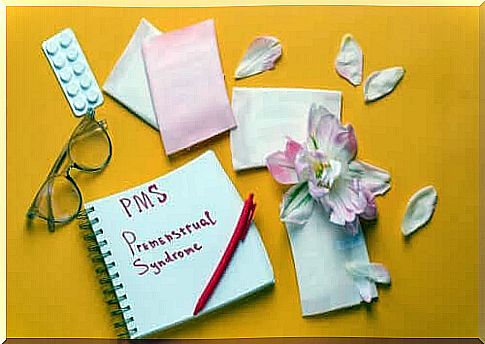Diet That Can Relieve Premenstrual Syndrome (PMS)

Premenstrual syndrome refers to a set of physical, psychological and behavioral symptoms that affect about 80% of women. It is also important to know that a more severe form is called premenstrual dysphoric disorder. This specific condition affects only between 1.3 and 5.3% of the population.
Premenstrual syndrome occurs during the luteal phase, after ovulation. It tends to last until the second or third day of menstruation.
Are you tired of these symptoms interfering with your daily life and of taking anti-inflammatory painkillers? Keep reading to discover how your diet can be a way to relieve premenstrual syndrome.
The clinical symptoms of premenstrual sensations
Premenstrual syndrome involves one or more of the following symptoms:
- Swelling of the abdomen.
- Pain in the breasts.
- Headache.
- Muscle or joint pain.
- Fluid retention.
- Weight gain.
- Anxiety.
- Difficulty concentrating.
- Fatigue.
- Irritability and mood swings.
- Depression.
In addition, these symptoms must occur for at least three consecutive menstrual cycles. In premenstrual dysphoric disorder, symptoms must occur for at least 5 consecutive cycles.

The causes of premenstrual syndrome
All symptoms have to do with fluctuations in the woman’s estrogen and progesterone levels. We see these symptoms when the woman’s estrogen levels are low and the progesterone levels are at max.
As a result, our neurotransmitter levels change – including serotonin, dopamine and GABA, whose function is to regulate our mood. They also compensate for our blood pressure by affecting the renin-angiotensin-aldosterone system.
The diet can be adjusted so that it focuses on providing the nutrients that reduce the symptoms of all these processes. In addition, it is nutrients that tend to decrease in amount during this phase. Other risk factors include tobacco and stress.
Diet as a means of relieving premenstrual syndrome
Why are inclusive omega-3 fatty acids important in relieving premenstrual syndrome?
They are anti-inflammatory and act on the brain in such a way that they improve one’s ability to concentrate and focus. This is because the brain is mostly made up of fat. Omega-3 fatty acids are the key to reducing the severity and duration of depression, swelling and anxiety.
Foods rich in omega-3 are fatty fish (sardines, salmon, anchovies and tuna), nuts (especially almonds and walnuts) and seeds. Evening primrose oil, which contains linoleic acid, is also known to be beneficial.
How to regulate your mood with vitamin B6
Vitamin B6 is a cofactor involved in the synthesis of tryptophan – a precursor to serotonin and dopamine. Therefore, it is essential to increase the intake of this vitamin, given that the levels often decrease around ovulation.
Lower levels of these neurotransmitters make us more sensitive, making it easier for us to become emotional and feel down.
You can find vitamin B6 in bananas, oatmeal, pure cocoa, pineapple, salmon, eggs and avocados.
Reduce muscle pain with magnesium
Magnesium is one of the minerals whose levels in our blood drop during this phase. In turn, this deficit leads to an increase in aldosterone levels, which leads to us retaining fluid and at the same time reducing dopamine levels.
In addition, the main function of magnesium is the communication between muscle fibers. Therefore, if we do not have sufficient reserves, we may experience seizures. You can find magnesium in seeds, legumes, millet and quinoa.
The synergy between calcium and vitamin D.
As I said, estrogen levels are low during this time. And what happens? PTH hormone levels increase, which makes calcium absorption more difficult. If vitamin D levels also happen to be low, this makes the situation even worse.
Therefore, it is extremely important to eat foods such as broccoli, kale, almonds, beans, yogurt, goat cheese, oily fish and eggs. And do not forget to go out for at least 15 minutes in the sun every day.

Foods that aggravate premenstrual syndrome
As with all other diseases, there are certain foods that aggravate the development and intensity of premenstrual syndrome. These include in particular the following:
- Alcohol.
- Coffee and energy drinks. The caffeine they contain reduces the reserves of vitamin B6. Coffee without caffeine and infusions is a good alternative.
- Soft drinks.
- Sweets, especially pastries.
- Fast food (pizza, burgers, etc.).
- Salty snacks.
- Fried food.
Exercise is also therapeutic
In addition to diet, exercise has a relaxing, analgesic and anti-inflammatory effect. It also improves mood because it stimulates the production of endorphins.
In addition, exercise has positive effects on our physical health and metabolism. The following statement sums it up quite well:
To get the most out of your workout, you should do cardio at least three times a week. This can be walking, running or cycling.
It is also good to combine cardio training with strength training. Be sure to consult a personal trainer who can indicate the correct technique to avoid injury.
Now you know everything you need to know about the therapeutic effects of nutrition and a healthy lifestyle to relieve premenstrual syndrome. Remember to set aside time to take care of yourself and get the rest you need.
It’s easy to forget that we need to take a break sometimes. Whether you believe it or not, your body works continuously – especially around the time of your period.









